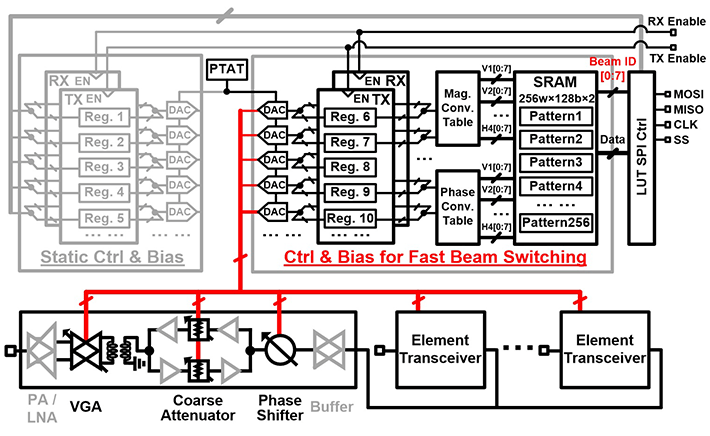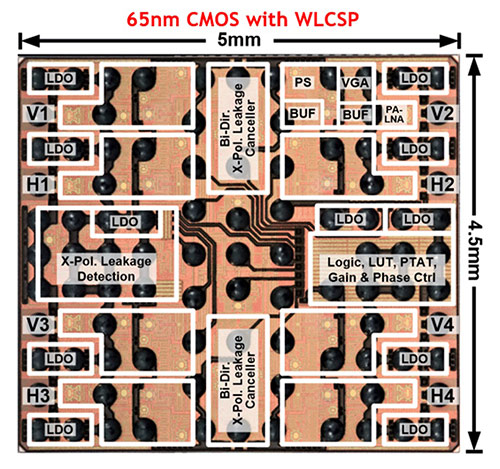Researchers from the Tokyo Institute of Technology and NEC Corporation developed a 28-GHz phased-array transceiver that supports efficient and reliable 5G communications.
Fifth-generation (5G) communication technology is looking to improve emerging technologies such as low-power IoT systems, smart cities, autonomous vehicles, and smart mobility. 5G bands have been broadly divided into two categories: sub-6 GHz (also called FR1) and mmWave (FR2). Sub-6 GHz band, as the name suggests, means frequency band below 6 GHz. Millimeter-wave or mmWave in 5G, on the other hand, has a frequency band from 24GHz to 52GHz. mmWave provides high bandwidth capacity making it suitable for a broad range of products and services, such as high-speed, point-to-point wireless local area networks, broadband, cellphones, and other wireless networks.
With mmWave band, 5G data rates can top up to 10 Gbps. But in the mmWave band, the data gets degraded over a longer distance and additionally gets attenuated by gases and moisture in the atmosphere. This impacts the signal-to-noise ratio of the channel. Therefore, the receiver is provided with multiple versions of the same signal, and the probability that they will all be affected simultaneously is considerably reduced. This technology that employs multiple transmitters and receivers to transfer more data at the same time is referred to as MIMO or multiple-in-multiple-out.
MIMO technology utilizes large-scale phased-array transceivers for controlling an array of antennas which creates a beam of radio waves that can be electronically steered to point in different directions without moving the antennas. Large-scale phased-array systems face several challenges such as increased power dissipation and implementation costs. One of the significant challenges currently is latency caused by beam switching time. Beam switching is an important feature that enables the selection of the most optimal beam for each terminal. For that reason, there is a strong need for a design that optimizes beam switching time.
Researchers from the Tokyo Institute of Technology and NEC Corporation in Japan collaborated to develop a 28-GHz phased-array transceiver that supports fast beam switching and high-speed data communication. The study will be presented at the 2021 Symposia on VLSI Technology and Circuits.
The proposed design facilitates dual-polarized operation, in which data is transmitted simultaneously through horizontal and vertical-polarized waves. Dual-polarized operation enhances the isolation between transmitter/receiver and doubles the capacity of communication systems through frequency reuse. However, there is an issue associated with these systems, cross-polarization leakage, which results in signal degradation, especially in the millimeter-wave band. To solve this issue, scientists devised a cross-polarization detection and cancellation methodology, using which they were able to suppress the leakages in both transmit and receive mode.

The proposed design consists of static elements that control the building blocks of the phased-array mechanism and an on-chip SRAM to store the settings for different beams. This parallel operation leads to fast beam switching with ultra-low latency being achieved. This mechanism, moreover, uses separate registers for transmitting and receiving modes enabling fast switching. The bi-directional architecture of the transceiver allows for a smaller chip size of 5mm × 4.5mm.

For a total of 256-pattern beam settings stored within the on-chip SRAM, a beam switching time of only 4 nanoseconds was achieved. Researchers also calculated Error vector magnitude (EVM)—a measure to quantify the efficiency of digitally modulated signals such as quadrature amplitude modulation (QAM). They found that the transceiver was supported with EVMs of 5.5% in 64QAM and 3.5% in 256QAM. The proposed transceiver outperforms state-of-the-art 5G phased-array transceivers in terms of switching time and MIMO efficiency.
Prof. Kenichi Okada, who led the research team, says about the impact of the proposed design, “Thanks to its rapid beam switching capabilities, it can be used in scenarios where enhanced multi-user perception is required. This device sets the stage for a myriad of applications, including machine connectivity and the construction of smart cities and factories.”








